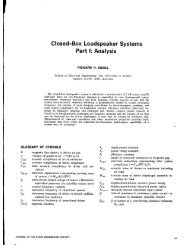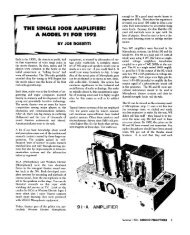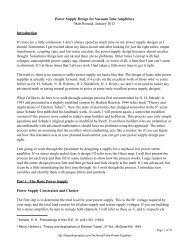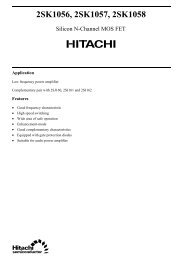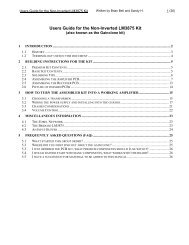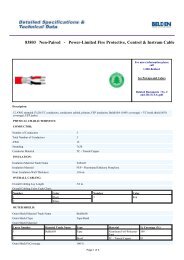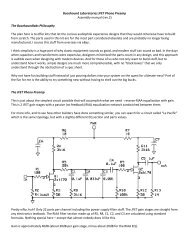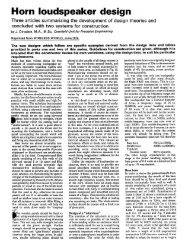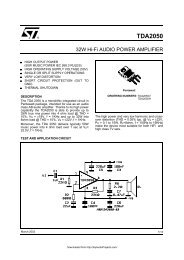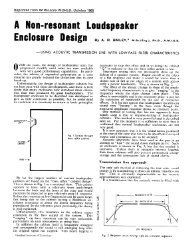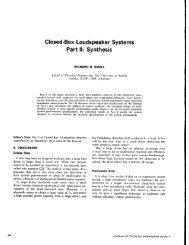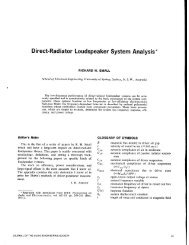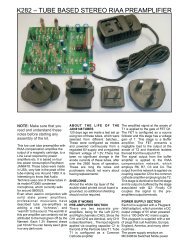S-5 Electronics K-12M - DIY Audio Projects
S-5 Electronics K-12M - DIY Audio Projects
S-5 Electronics K-12M - DIY Audio Projects
Create successful ePaper yourself
Turn your PDF publications into a flip-book with our unique Google optimized e-Paper software.
S-5 <strong>Electronics</strong> K-<strong>12M</strong><br />
Reviewed by Charles Hansen and Duncan and Nancy MacArthur<br />
S-5 <strong>Electronics</strong>, 1625 Twin Acres,<br />
Chandler, AZ 85249, 480-895-<br />
2521, FAX 480-895-4164. Kit<br />
price $140 or $170 assembled/<br />
tested; plus $10 shipping. Dimensions:<br />
9.5″W × 4.5″H × 7″D. Warranty<br />
90 days.<br />
The S-5 <strong>Electronics</strong> K-<strong>12M</strong> is<br />
a push-pull stereo power<br />
amplifier rated for 8W per<br />
channel. The review unit came<br />
fully assembled, but I did receive<br />
the three-page kit assembly instructions<br />
along with the onepage<br />
operating instructions. The<br />
assembly instructions were brief<br />
but thorough, and presume that<br />
you have had prior kit-building<br />
experience and understand electronic<br />
components.<br />
CONSTRUCTION<br />
The amplifier doesn’t come with<br />
an enclosure. A 7″ × 10.5″ pine<br />
board is furnished, along with a<br />
mounting/drilling template. The<br />
finished “breadboard” is shown in<br />
Photo 1. The PC board and transformers<br />
are mounted to the board<br />
with screws.<br />
The front of the unit has two<br />
gold-plated phono jacks and a<br />
stereo volume control, both attached<br />
to the PC board. Two pairs<br />
of gold-plated speaker binding<br />
posts are located on the PC board<br />
just in front of the output transformers.<br />
These binding posts are<br />
spaced ¾″ apart, so you can use<br />
dual banana plugs.<br />
The unit is furnished with a<br />
two-prong power cord, with a<br />
table-lamp-style in-line switch<br />
and an in-line fuse holder. One of<br />
the power-cord connections to the<br />
power transformer primary is made<br />
with a small wire nut. For safety’s<br />
sake, I would pursue a metal enclosure<br />
for this amplifier. The<br />
tubes run very hot, and high voltages<br />
are present on the PC board.<br />
The PC board is a very nice<br />
silkscreened double-sided glass<br />
epoxy board with a solder mask. It<br />
mounts to the pine board on four<br />
6mm nylon spacers and the aforementioned<br />
screws. Ceramic tube<br />
sockets hold the four tubes.<br />
TUBE-POLOGY<br />
A schematic was supplied with<br />
both the operating and the assembly<br />
instructions. Two 11MS8 triode-pentode<br />
vertical deflection<br />
PHOTO 1:<br />
K-<strong>12M</strong> front view.<br />
amplifier tubes are used in each<br />
channel. The input signals are capacitively<br />
coupled to the 100k<br />
stereo pot.<br />
The pot wiper connects to the<br />
grid of one of the triode sections<br />
used as a cascade amplifier. This<br />
triode drives the grid of the second<br />
triode, configured as a splitaudioXpress<br />
November 2002 47
load phase inverter. This stage is<br />
capacitively coupled to the two<br />
push-pull pentode sections. Feedback<br />
is taken from the 8Ω secondary<br />
of the output transformer<br />
(the only tap available) to the<br />
cathode of the input triode.<br />
All the coupling caps are metallized<br />
polyester, and Samsung aluminum<br />
caps are used to filter the<br />
full-wave solid-state power supply.<br />
Resistors are carbon film and metal<br />
oxide types. The volume control is<br />
a dual ⁵⁄₈″ nondescript carbon pot.<br />
The three transformers are marked<br />
with a “UTK” logo.<br />
S-5 <strong>Electronics</strong> supplied four<br />
11MS8 “Made in Japan” tubes with<br />
this K-<strong>12M</strong>, packed as pairs in<br />
cardboard tubes. The 11.6V<br />
heaters are supplied from the<br />
“12V” AC winding of the power<br />
transformer. I measured an actual<br />
11.5V AC at the heaters.<br />
MEASUREMENTS<br />
I operated the K-<strong>12M</strong> at 1W 1kHz<br />
into 8Ω for one hour to burn in<br />
the unit before measurements. The<br />
test data is summarized in Table 1.<br />
There was only a very low level of<br />
hum with my ear against the<br />
speaker, and no noise during<br />
power-up or shutdown.<br />
Initially, the distortion (THD+N)<br />
in each channel measured 1.5%,<br />
but increased to 5% left and 2.9%<br />
right after the hour. I swapped<br />
tubes around to try to achieve a<br />
lower THD and settled on the<br />
“best” arrangement, which produced<br />
1.6% left and 2.5% right<br />
after an additional hour of run-in.<br />
The K-<strong>12M</strong> does not invert polarity.<br />
Input impedance at 1kHz<br />
was 81k left and 88k right, so this<br />
nominal 100k pot is on the low<br />
side. Volume control tracking was<br />
within 1dB from 10 o’clock to<br />
3 o’clock, where it improved to less<br />
than 0.5dB up to full volume.<br />
The full-volume gain at 2.83V<br />
RMS output into 4Ω and 8Ω loads<br />
was 25dB and 28dB, respectively.<br />
The output impedance was quite<br />
high: 6.6Ω at 1kHz and 5.5Ω at<br />
both 20Hz and 20kHz.<br />
The frequency response for the<br />
K-<strong>12M</strong> was within −3dB from 14Hz<br />
to 58kHz, at an output of 1W at<br />
1kHz into 8Ω. I measured −1dB at<br />
20Hz and −2.8dB at 20kHz. This<br />
data, along with the response for<br />
2W into 4Ω, and 8Ω paralleled<br />
FIGURE 1: Frequency response.<br />
FIGURE 2: THD+N versus output power.<br />
FIGURE 3: THD+N versus frequency.<br />
0<br />
-10<br />
-20<br />
-30<br />
-40<br />
-50<br />
-60<br />
-70<br />
-80<br />
-90<br />
dB<br />
kHz<br />
-100<br />
0.0 0.2 0.4 0.6 0.8 1.0 1.2<br />
S-5 K<strong>12M</strong><br />
Spectrum 50Hz Sine Wave 1W 8ohms<br />
G-2145-4<br />
of -<br />
FIGURE 4: Spectrum of 50Hz sine wave.<br />
with 2µF, is shown in Fig. 1. The<br />
dashed line in the figure represents<br />
the response to an IHF<br />
speaker load, which has an impedance<br />
peak at 50Hz. This amplifier<br />
will be extremely sensitive to any<br />
variations in speaker impedance<br />
with frequency, and will color the<br />
sound accordingly.<br />
Hum and noise (maximum volume,<br />
input shorted) measured<br />
0.6mV left and 0.2mV right. Viewing<br />
the noise content on an oscilloscope<br />
showed a 60Hz waveform<br />
with some noise, and obvious<br />
spikes near each power line zerocrossing,<br />
presumably due to rectification.<br />
Crosstalk was noticeably higher<br />
L to R than R to L, as you can see<br />
in Table 2. The 100Hz levels are<br />
dominated by noise, while the<br />
fundamental test signal was predominant<br />
at 1kHz and higher due<br />
to capacitive coupling.<br />
Figure 2 shows THD+N versus<br />
G-2145-1<br />
G-2145-2<br />
G-2145-3<br />
0<br />
-10<br />
-20<br />
-30<br />
-40<br />
-50<br />
-60<br />
-70<br />
-80<br />
-90<br />
dB<br />
V<br />
6<br />
4<br />
2<br />
0<br />
-2<br />
-4<br />
-6<br />
-8<br />
-10<br />
V<br />
12<br />
-4<br />
-8<br />
-12<br />
-16<br />
-20<br />
output power for various loads and<br />
frequencies. Notice the vertical<br />
THD scale, which is an order of<br />
magnitude higher than I usually<br />
require. I engaged the test set<br />
80kHz low-pass filter to limit the<br />
out-of-band noise.<br />
The right channel distortion<br />
(the two dashed curves) was significantly<br />
higher than the left channel.<br />
I was only able to obtain the<br />
rated 8W power at 1kHz with a 4Ω<br />
load, this at 28% distortion. The<br />
-100<br />
0 5 10 15 20<br />
S-5 K<strong>12M</strong><br />
Spectr um of1kHz Sine Wave -1W 8ohms<br />
FIGURE 5: Spectrum of 1kHz sine wave.<br />
0.0 0.2 0.4 0.6 0.8 1.0 1.2 1.4 1.6 1.8 2.0<br />
8<br />
4<br />
0<br />
S-5 K<strong>12M</strong><br />
Residual Distortion - 1kHz 1W 8ohms<br />
FIGURE 6: Residual distortion, 1kHz 1W 8Ω.<br />
-2<br />
0.0 0.2 0.4 0.6 0.8 1.0 1.2 1.4 1.6 1.8 2.0 ms<br />
S-5 K<strong>12M</strong><br />
Residual Distortion - 1kHz 8W 4ohms<br />
FIGURE 7: Residual distortion, 1kHz 8W 4Ω.<br />
V<br />
6<br />
4<br />
2<br />
0<br />
-2<br />
-4<br />
-6<br />
-8<br />
-10<br />
0 10 20 30 40 50 60 70 80 90 100<br />
S-5 K<strong>12M</strong><br />
ResidualDistortion - 20Hz 1W 8ohms<br />
FIGURE 8: Residual distortion, 20Hz 1W 8Ω.<br />
G-2145-5<br />
V<br />
2.0<br />
1.6<br />
1.2<br />
0.8<br />
0.4<br />
0.0<br />
-0.4<br />
-0.8<br />
ms<br />
G-2145-6<br />
V<br />
5<br />
4<br />
3<br />
2<br />
1<br />
0<br />
-1<br />
V<br />
5<br />
4<br />
3<br />
2<br />
1<br />
0<br />
-1<br />
-2<br />
ms<br />
kHz<br />
G-2145-7<br />
G-2145-8<br />
48 audioXpress 11/02 www.audioXpress.com
■ CRITIQUE<br />
■ Reviewed by Duncan and Nancy MacArthur<br />
What can you get for $140 nowadays? If you’re willing to<br />
play by the rules as defined by this integrated amplifier,<br />
the answer is quite a bit. The K-<strong>12M</strong> produces a smooth,<br />
musical sound that rarely offends. When coupled with<br />
appropriate components, it is a joy to hear. We have not<br />
heard a better-sounding amplifier in this price range.<br />
GUIDELINES<br />
Unfortunately, during the listening process we discovered<br />
a significant problem with this amplifier’s construction.<br />
After about 75 hours of operation at moderate<br />
levels, all four of the tube sockets were scorched and<br />
slightly melted. We discussed this problem with Larry<br />
Stafford at S-5. He mentioned that this socket problem<br />
is not limited to our sample and that S-5 is investigating<br />
ceramic sockets. We would not recommend the K-<br />
<strong>12M</strong> amplifier unless these sockets are replaced. Once<br />
the sockets are replaced, we’d suggest the following<br />
guidelines for enjoying the K-<strong>12M</strong> amplifier:<br />
1. The K-<strong>12M</strong> needs efficient speakers. Eight watts<br />
are only 8W. When paired with 91dB/W speakers, the K-<br />
<strong>12M</strong> played loudly enough to make conversation impossible<br />
in a small room but not loudly enough to move<br />
objects or hurt eardrums. When we switched to Genesis<br />
400 speakers with an efficiency (on a good day) of<br />
89dB/W, the K-<strong>12M</strong> amplifier played beautifully at<br />
lower levels. At higher levels the highs became hard<br />
and the midrange congested. Playing the K-<strong>12M</strong> loudly<br />
through our less-efficient speakers made our ears suffer<br />
(and not just from the volume).<br />
2. Don’t expect ultimate bass extension and dynamics.<br />
Although the K-<strong>12M</strong>’s midrange was excellent and<br />
its highs extended, its deep bass, while present, was<br />
notably weak. We didn’t notice this lack on many types<br />
of music (vocals, strings, piano, and so on). But the<br />
slam was missing from the bass drums, and the fundamentals<br />
were gone from the low organ notes, on any<br />
music that included these instruments.<br />
3. The K-<strong>12M</strong> is not a complete amplifier. A kit including<br />
electrical parts and PCB is available for $140, and<br />
an “assembled” version costs $170; however, neither<br />
version could be used in any but the most monastic<br />
environment without adding an enclosure, knobs, and<br />
connectors. This flaw isn’t fatal in this price range,<br />
and the manufacturer prominently mentions the need<br />
for building an enclosure in the instructions. On the<br />
other hand, you should be aware that $140 (or $170)<br />
probably won’t be the final price.<br />
In fairness, the K-<strong>12M</strong>, as supplied, is a completely<br />
operational amplifier using only the parts included in the<br />
kit. As I write this, I am listening to a K-<strong>12M</strong> with the<br />
sole addition of an overturned milk crate to keep pets<br />
and children at bay. Although this combination sounds<br />
excellent playing Beethoven (Robert Silverman, pianist,<br />
Ludwig Van Beethoven’s Complete Piano Sonatas,<br />
Stereophile KSP 830), its looks and long-term safety are<br />
not appropriate in a household with children, animals, or<br />
even other (non-fanatic) adults. The K-<strong>12M</strong> kit offers the<br />
opportunity to audition the sound before you spend more<br />
money on cosmetic and safety requirements.<br />
Spousal note: Let me add another perspective on<br />
this issue: the K-<strong>12M</strong> as it stands is a circuit board<br />
and transformers on a raw pine board. Its appearance<br />
is unlikely to find favor with even an extremely tolerant<br />
spouse. To maintain domestic harmony, plan on building<br />
an enclosure. (S-5 has a good-looking example on<br />
their website at s5electronics.com.) Your loved ones<br />
will thank you.—NM<br />
VOLUME MATTERS<br />
Our sample of the K-<strong>12M</strong> arrived with a damaged volume<br />
control, which extends beyond both the PCB and<br />
the breadboard. According to S-5, this type of damage<br />
isn’t uncommon. Replacing the pot isn’t difficult given a<br />
little soldering skill, but in our case the pot had failed<br />
open—resulting in a full-power buzz through the offending<br />
channel. At this point we were glad that the K-<br />
<strong>12M</strong> only produced 8W per channel. Once we replaced<br />
the pot, we had no operational problems with the K-<br />
<strong>12M</strong>. (The melting tube sockets we mentioned earlier<br />
caused no operational problems, but left us wondering<br />
about the longevity of the amplifier.)<br />
The volume pot on the K-<strong>12M</strong> appears to have a linear<br />
taper rather than the more common logarithmic<br />
taper. The linear taper makes the channel-to-channel<br />
tracking better but caused most of our listening to take<br />
place below “9 o’clock” on the pot. Using this type of<br />
pot probably represents a reasonable compromise in<br />
an inexpensive amplifier.<br />
The lack of a “power on” indicator occasionally became<br />
confusing. Several times we resorted to resistance<br />
measurements to check the position of the (unmarked)<br />
AC switch before inserting the plug. Although the K-<br />
<strong>12M</strong>’s speaker connectors are typical “5-way” terminals,<br />
they are mounted in such a way that banana plugs are<br />
the only easy way to connect your speaker cables.<br />
DETAILED LISTENING RESULTS<br />
We auditioned the K-<strong>12M</strong> using Genesis 400 and Audax<br />
A-652 speaker systems. Following our standard 50-hour<br />
break-in period (during which we observed little<br />
change), we did most of our serious listening with the<br />
Genesis speakers. We briefly compared the K-<strong>12M</strong> directly<br />
with our reference tube integrated amplifier, the<br />
Manley Stingray. This comparison is absurd, as the<br />
sales tax on the Manley probably would be more than<br />
the cost of the entire K-<strong>12M</strong>. Suffice it to say that the<br />
Stingray sounds better, as well it should.<br />
We also compared the K-<strong>12M</strong> with our son’s solidstate<br />
(of course) boom box as well as with an older<br />
solid-state <strong>Audio</strong> Source AMP-1. The comparison with<br />
the boom box was again extremely one-sided, but this<br />
time in favor of the K-<strong>12M</strong>. Although the boom box has<br />
a solid-state amplifier “rated” at 72Wpc as opposed to<br />
the K-<strong>12M</strong>’s 8Wpc, the K-<strong>12M</strong>’s bass response was<br />
tighter, deeper, and better defined.<br />
The K-<strong>12M</strong>’s midrange was clearer, better defined,<br />
and more dynamic. The high-frequency response of the<br />
K-<strong>12M</strong> was more extended. In short, the K-<strong>12M</strong> integrated<br />
amplifier represents a sonically valid step up<br />
from the amplifier included in the all-in-one systems<br />
to page 51<br />
audioXpress November 2002 49
maximum power available at 20Hz<br />
was a meager 2W, with 20kHz producing<br />
almost 5W, both again at<br />
distortion levels above 25%. At full<br />
power the supply transformer and<br />
tubes audibly resonated at the test<br />
signal frequency.<br />
The clipping level is normally<br />
defined as that power where<br />
THD+N reaches 1%. However, the<br />
baseline distortion in tube amplifiers<br />
is fairly high at low power<br />
levels, so the generally accepted<br />
practice is to use 3% THD+N as the<br />
clipping point. Even with that allowance,<br />
this little amplifier was<br />
well into clipping at 2W or less, depending<br />
on the test condition. I<br />
never saw less than 1% THD+N for<br />
any test condition except at 0.1W<br />
into 8Ω 1kHz. Swapping the tubes<br />
around also affects the distortion,<br />
even for a left-right swap in the<br />
same channel.<br />
The THD+N versus frequency for<br />
2W into 4Ω and 1W into 8Ω is<br />
shown in Fig. 3. Here you can see<br />
the high levels of distortion, especially<br />
at low frequencies (LF). The<br />
right channel produces noticeably<br />
more distortion than the left, but<br />
neither channel quite gets down<br />
to the 1% maximum listed in the<br />
specifications.<br />
The spectrum of a 50Hz sine<br />
wave at 1W into 8Ω is shown in<br />
Fig. 4, from zero to 1.3kHz. The<br />
THD+N measures 2.2%, and the<br />
harmonics are distributed<br />
throughout the spectrum. The second,<br />
third, fourth, and fifth measure<br />
−31dB, −36dB, −37dB, and<br />
−45dB, respectively. You can also<br />
see −57dB power-supply artifacts<br />
at 60Hz and 180Hz.<br />
I also recorded a 1W 1kHz 8Ω<br />
spectrum in Fig. 5 from zero to<br />
20.8kHz, where fewer harmonics<br />
are present. This produces the lowest<br />
THD+N reading at 1.3%.<br />
The left channel distortion<br />
waveform for 1W into 8Ω at 1kHz<br />
is shown in Fig. 6. The upper waveform<br />
is the amplifier output signal,<br />
and the lower waveform is the<br />
monitor output (after the THD test<br />
set notch filter), not to scale. The<br />
1.3% distortion residual signal<br />
shows mainly the second and third<br />
harmonics, with no evidence of<br />
any noise or fuzz.<br />
The clipping at maximum power<br />
(8W 1kHz 4Ω) shows a scoopedout<br />
positive half-cycle, and a noticeably<br />
asymmetrical negative<br />
half-cycle (Fig. 7). However, the<br />
residual distortion waveform is<br />
still predominantly second and<br />
third harmonic.<br />
In Fig. 8, I show the left channel<br />
response to a 20Hz sine wave, amplified<br />
to 1W with an 8Ω load. You<br />
can readily see the distortion in<br />
the fundamental signal (top), with<br />
the residual distortion waveform<br />
shown below. THD+N measures a<br />
high 21%. Since the LF power is<br />
quite limited, I assume this LF distortion<br />
is due to output transformer<br />
saturation. None of the<br />
coupling capacitor −3dB points are<br />
higher than 10Hz, even allowing<br />
for the actual 81k input pot resistance<br />
and capacitor tolerances.<br />
Figure 9 shows the K<strong>12M</strong>’s output<br />
spectrum reproducing a combined<br />
19kHz + 20kHz intermodulation<br />
distortion (IMD) signal at<br />
12Vpp (about 2.2W) into 8Ω. The<br />
nonlinear tube transfer characteristics<br />
produce a wide range of intermodulation<br />
products. The 1kHz<br />
IMD product is a high 1.25%, with<br />
the 18kHz product about the same<br />
level.<br />
REFERENCES<br />
1. “Guitar Direct Box,” Hansen, C., Performer’s<br />
<strong>Audio</strong>, pp. 18–21, 44–45, 3/97.<br />
0<br />
-10<br />
-20<br />
-30<br />
-40<br />
-50<br />
-60<br />
-70<br />
-80<br />
-90<br />
0<br />
-10<br />
-20<br />
-30<br />
-40<br />
-50<br />
-60<br />
-70<br />
-80<br />
-90<br />
dB<br />
dB<br />
The 12Vpp output test level for<br />
a multi-tone intermodulation signal<br />
(MIM, Fig. 10) of 9kHz +<br />
10.05kHz + 20kHz produced a<br />
1kHz response product of 0.89%. I<br />
also plotted the 1kHz product of<br />
this MIM signal versus output<br />
power in Fig. 2. This gives a better<br />
TABLE 1<br />
MEASURED PERFORMANCE<br />
indication of the K<strong>12M</strong>’s nonlinear<br />
response, since it is a closer approximation<br />
to music than a sine<br />
wave.<br />
I applied square waves to the<br />
input of the K<strong>12M</strong> at three frequencies.<br />
The 2.5Vpp square wave<br />
at 40Hz into 8Ω showed signifi-<br />
PARAMETER MANUFACTURER’S RATING MEASURED RESULTS<br />
Input impedance 100kΩ 81k left, 88k right<br />
Output impedance 8Ω 6.6Ω at 1kHz;<br />
5.5Ω at 20Hz, 20kHz<br />
Power output, maximum 8W per channel 8W 1kHz 4Ω (28% THD)<br />
Minimum input for full 0.4V 0.427V RMS, 1kHz<br />
output<br />
-100<br />
0 5 10 15 20<br />
S-5 K<strong>12M</strong><br />
Intermodulation Spectrum19+20kHz 0dBfs 8ohms<br />
-100<br />
0 5 10 15 20<br />
S-5 K<strong>12M</strong><br />
Intermodulation Spectrum 9+10.05+20k Hz 0dBfs 8ohms<br />
FIGURE 10: Spectrum of 9kHz + 10.05kHz + 20kHz intermodulation<br />
signal.<br />
8Ω<br />
0.504V RMS, 1kHz<br />
4Ω<br />
Frequency response 20Hz–20kHz 14Hz–58kHz ±3dB<br />
8Ω<br />
Total harmonic distortion
from page 49<br />
typically owned by beginning listeners.<br />
The comparison between the AMP-1 and the K-<strong>12M</strong><br />
was much closer. The AMP-1 had a deeper and<br />
stronger bass response and an overall good sound, but<br />
when compared with the K-<strong>12M</strong> it sounded slightly<br />
harsh, unnatural, and “hi-fi.” Although the AMP-1 was<br />
significantly more expensive, we both preferred the<br />
natural sound of the K-<strong>12M</strong>.<br />
We auditioned the K-<strong>12M</strong> using a number of tracks<br />
from the Hi-Fi News and Record Review Disk III (track<br />
2: Parry’s “Jerusalem”; track 4: Vivaldi’s trumpet concerto;<br />
tracks 5 and 6: excerpts from Prokofiev’s “Peter<br />
and the Wolf”; track 7: Purcell’s “Welcome, Welcome<br />
Glorious Morn”; track 10: a Corkhill percussion piece;<br />
and track 14: Rio Napo RSS demo). We also listened to<br />
a wide variety of other CDs, including a recent live<br />
album by BROTHER (This Way Up, Rhubarb Records<br />
RR07CD). See sidebar.<br />
The K-<strong>12M</strong> produced an enjoyable sound with music<br />
ranging from Jethro Tull (A Little Light Music,<br />
Chrysalis, F2-21954) to Mozart (Horn Concertos, Dennis<br />
Brain, EMI CDH 7 61013 2). It was at its best reproducing<br />
instruments such as the horns and oboes in<br />
“Peter and the Wolf” and the trumpets in the Vivaldi<br />
trumpet concerto.<br />
The high-frequency response of the winds in “Peter<br />
and the Wolf” was clean, sweet, and reasonably detailed,<br />
but the high frequencies of cymbals and miscellaneous<br />
noises on the “Rio Napo DSS Demonstration”<br />
were slightly recessed and lacking in sparkle. When we<br />
played the Purcell at reasonable volumes, the K-<strong>12M</strong>’s<br />
sound was uncongested and very musical; however, this<br />
quality suffered as we increased the volume.<br />
As you might expect, the K-<strong>12M</strong> amplifier lacked the<br />
extreme clarity and detail produced by some much more<br />
expensive amplifiers. Microdynamic contrasts were excellent;<br />
the Corkhill percussion pieces were crisp, and<br />
the individual drumbeats in the RSS demonstration were<br />
well defined, fast, and solid. Rhythmic recordings, including<br />
several songs from the BROTHER CD, generated<br />
an appropriate feeling of aliveness. This dynamic quality<br />
was lost at higher volumes.<br />
At higher volumes some glare also became apparent<br />
TEST FOR TRANSIENTS, BASS, IMAGING, AND “SLAM”<br />
BROTHER is a rock band with roots in Australia; they add bagpipes and digeridoo to the usual mix of guitars,<br />
vocals, and drums. Their live album, This Way Up (Rhubarb Records RR07CD), contains two tracks that test a<br />
music system’s ability to reproduce bass transients realistically. BROTHER’s recordings probably aren’t available<br />
at your local CD store, but you can order them online at http://brothermusic.com/. (If you’re wondering<br />
what a digeridoo is, this page has some good pictures.)<br />
On a good system the drums on track 1, “Thetimeisnow,” sounds as close to “live” as I’ve heard from a CD.<br />
The bass drum, although not especially deep, is fast, rhythmic, and insistent. If you are at all given to tapping<br />
your toes or stamping your feet in time with music, this track should get you going.<br />
The drum sound on track 5, “The Unknown (Granny MacLeod & Rory MacLeod),” is deeper and less defined<br />
than on “Thetimeisnow” but just as insistent. This tune is another “foot-stomper”—with good woofers you<br />
should be able to feel each drumbeat. The digeridoo sounds as unique as it looks, and on this track it should be<br />
appropriately “twangy” with a deep bass fundamental. If it sounds like any normal instrument, the midrange<br />
resolution of your system and/or room needs work.<br />
Both tracks have a very strong bagpipe lead. The bagpipe isn’t a kind instrument to digital recording techniques.<br />
If you’ve turned these pieces up loudly enough to feel the drum and the bagpipe doesn’t drive you out of<br />
the room, you’ve solved your digital sound problem.<br />
On a good system the drum kit on both tracks is clearly located between the speakers (fairly easy), behind<br />
the speakers (harder), and significantly above the speakers (harder still). The drummer on this live album<br />
probably was sitting on a platform behind the other musicians. This spatial information is present on the CD<br />
and can be retrieved by a good reproduction system.—N + DM<br />
on midrange instruments such as horns. The Vivaldi<br />
trumpet concerto made us cringe at high volume, although<br />
it sounded fine at our normal listening levels.<br />
The K-<strong>12M</strong> was capable of reproducing a reasonable<br />
amount of ambience information. On the recording<br />
of “Jerusalem” the space around and above the<br />
choir was clearly audible. The K-<strong>12M</strong> produced a wide<br />
soundstage extending beyond the speakers on the<br />
“RSS Demonstration”; however, the instruments were<br />
not precisely placed within that soundstage but were<br />
slightly smeared. The drum kit on the BROTHER<br />
recording was appropriately centered, located above<br />
and to the rear of the other instruments.<br />
FINAL THOUGHTS<br />
NM: Tube amplifiers often receive good reviews for<br />
sound but poor reviews for measurements. For me a<br />
component’s sound—particularly its sound when<br />
played with our system—takes precedence.<br />
The K-<strong>12M</strong>’s sound coupled with its modest price<br />
tag blew me away. I’ve heard amplifiers I liked better<br />
with our system but none for under $800. If you’d told<br />
me before I heard the K-<strong>12M</strong> that a $140 amplifier<br />
could sound this good, I wouldn’t have believed you.<br />
That being said, I have a few reservations. Don’t<br />
buy this amplifier if you have inefficient speakers, if<br />
you must have deep bass, or if you’re unwilling to build<br />
a box for it. The melted tube sockets (and to a lesser<br />
extent the easily-damaged volume control) still worry<br />
me. S-5 tells us they will try to replace the tube sockets.<br />
If they haven’t done so before you buy this amplifier,<br />
consider either postponing the purchase or replacing<br />
the sockets yourself.<br />
DM: The K-<strong>12M</strong> has many of the sonic characteristics<br />
attributed to classic tube designs. It possesses<br />
a wonderful midrange, a clean but slightly rolled off<br />
high end, and a somewhat muddy bass response. Although<br />
I have not compared the K-<strong>12M</strong> directly to<br />
any of the classic designs, to my ears its deficiencies<br />
are less pronounced than those of many earlier<br />
amplifiers. Its combination of midrange and high<br />
frequency response is ideally suited to taming the<br />
sound of an inexpensive CD player.<br />
to page 52<br />
Your online source for name brand audio tubes<br />
• Over 1000 types available online<br />
• Perfect Pair matched power tubes<br />
• Capacitors and sockets<br />
Order online at<br />
or call toll free 1-877-570-0979<br />
audioXpress November 2002 51
cant tilt, as you can<br />
see in Fig. 11. This is<br />
indicative of the fairly<br />
high 14Hz −3dB point<br />
in this design.<br />
The 10kHz square<br />
wave showed one halfcycle<br />
of peaking at the<br />
leading edge (Fig. 12).<br />
This peak was also<br />
present in the 1kHz<br />
square wave response<br />
(not shown). The leading<br />
edge of the 10kHz<br />
square wave showed a<br />
full cycle of ringing<br />
when I connected 2µF<br />
in parallel with the 8Ω<br />
load. However, there<br />
was no evidence of additional<br />
high-frequency<br />
peaking or instability,<br />
nor did I measure<br />
any in the frequency<br />
response test (Fig. 1).<br />
After the measurements,<br />
I installed the<br />
K<strong>12M</strong> in my system<br />
for some brief listening.<br />
Then I had the<br />
idea to connect the<br />
left channel to my<br />
guitar amplifier speaker via my<br />
guitar direct box 1 . With its distortion<br />
performance, I found it to be<br />
a terrific little practice amplifier.<br />
The bass was reasonably full, and<br />
the high end had “bite” but without<br />
any treble harshness. The treble<br />
responded nicely to string dynamics,<br />
with easily controllable<br />
overload distortion at high volumes.<br />
Maybe the best enclosure<br />
for this little tube amp would be<br />
two reasonably efficient 8″ musical<br />
instrument drivers in a cabinet.<br />
Manufacturer’s response:<br />
In keeping low cost and ease of<br />
construction as primary goals,<br />
the design was optimized for<br />
practical use with emphasis on<br />
the musical listening experience.<br />
NM’s comment “The S-5’s<br />
sound coupled with its modest<br />
price tag blew me away” attests<br />
to the design success.<br />
We also comment that the<br />
tube sockets used have been<br />
completely satisfactory in the<br />
field with over 100 amplifiers in<br />
use by customers. We still plan<br />
to change to ceramic sockets,<br />
from page 51<br />
Along with the classic sonic signature,<br />
the K-<strong>12M</strong> integrated amplifier<br />
has managed to retain a price reminiscent<br />
of yesteryear. If its tube sockets<br />
were replaced, I would unhesitatingly<br />
recommend the inclusion of the<br />
K-<strong>12M</strong> in a starter system, assuming<br />
you’ve considered the three guidelines<br />
mentioned in the introduction. If you’re<br />
even slightly competent with a soldering<br />
iron, I recommend buying the<br />
K-<strong>12M</strong> as a kit, not because the price<br />
is lower but because fitting an enclosure<br />
and replacing the sockets will be<br />
easier. Also, the volume control probably<br />
won’t break if it’s shipped as part<br />
of a kit.<br />
❖<br />
but this necessitates changes in<br />
the circuit board, which requires<br />
considerable lead time.<br />
We also point out that the<br />
need for output power has been<br />
generally over-emphasized. Practical<br />
listening levels are of the<br />
order of 1W per channel. ❖<br />
Larry Stafford<br />
S-5 <strong>Electronics</strong><br />
A Proud North American Distributor of<br />
ACCUTON<br />
P.O. Box 9085, Wichita Falls, TX 76308, USA<br />
Phone: (940) 689-9800; Fax: (940) 689-9618; E-mail: mail@soniccraft.com<br />
See us at: www.soniccraft.com<br />
52 audioXpress 11/02 www.audioXpress.com



